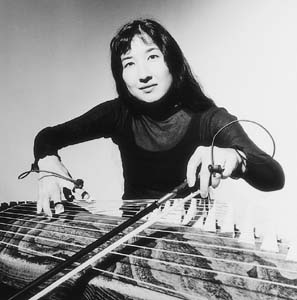![[Metroactive Music]](/music/gifs/music468.gif)
[ Music Index | San Jose | Metroactive Central | Archives ]
 Improvised Turmoil: Miya Masaoka has collaborated with everyone--and thing--from Pharoah Sanders to a box full of bees. Challenging the Koto-Monster Tradition meets the cutting edge when Miya Masaoka manipulates her koto By Marianne Messina ALTHOUGH MIYA MASAOKA plays the Japanese koto, an instrument wrapped in more than 1,000 years of tradition, there isn't much that's traditional about her. Masaoka has taken her "note-bending zither," her refined technique, her Gagaku (formal court music) training under a Sensei who can trace his lineage back 1,000 years, and she has hybridized them almost beyond recognition by interfacing not only with improvisational jazz but also with technology. This year, for example, at the San Francisco Electronic Music Festival, Masaoka made music by dancing: her movements triggered laser sensors on what she calls her "koto-monster," a mutant koto she created with a team of musical hardware and software experts at the STEIM Institute in Amsterdam. Like other Mills College alumni (John Cage, et al.), Masaoka hounds the cutting edge in search of new voices for the human artistic impulse--in fact she originally chose Mills because, as she put it, "There's not a lot of academic fat there" (fat being instructors whose "careers in academia affect their perspective on the art"). It is easy to understand a certain sympatico between Masaoka and innovative performance artists like Laurie Anderson, whom Masaoka interviewed on a recent pass through the Bay Area. She celebrated Anderson as a "master of minutiae," for being able to "find meaning and humor in the most banal gestures of day-to-day existence." Masaoka, too, combines humor and brief sound statements in her style, and incorporates technology "as a rigid interface shaping how work is created." Her history of composition and performance is more a series of phenomena than a career. She appears phantomlike on collaborative CDs with various improv geniuses: saxophonist Pharoah Sanders and clarinetist Ben Goldberg, or in duet with trombonist George Lewis (The Usual Turmoil). But largely, Masoaka's body of work consists of one-time events. She might sit down with a coterie of musicians to improvise the soundtrack for a silent film, as she did for A Page of Madness. Or, inspired by artistic questions, she might set up and accompany an elaborate environmental soundscape. The question "Do bees improvise?" gave way to a composition she brought out for SoundCulture'96, in which she collaborated on koto with about 3,000 bees. Four-foot-square glass encasements with holes in the top for microphones housed the bee hives, where bees, Masaoka claims, normally buzz somewhere around middle C. After finding that "a critical mass of bees" isolated in smaller environments would vary their wing rhythms, she created a system of amplified glass tubes for the harmonizing bees that she then "mixed into the sound landscape." One of Masaoka's questions, "What Is the Sound of Ten Naked Asian Men?" did, in fact, involve an "orchestra" of naked men, prone on massage tables with audio pickups on various parts of their bodies to amplify natural sounds like heart-beating, stomach-growling and throat-swallowing. Layered and remixed, the somatic sounds gave Masaoka and her koto a lively jam session. When she gets down to the business of improvising with these soundscapes, Masaoka has been known to hit the koto strings with a rubber ball (no wonder she was at first reluctant to have her revered koto instructor see her work). And though she reports that bowing is a favored technique, she can also be seen plucking, slapping and rubbing the strings. In performance, as in composition, Masaoka's a kind of restless synthesist in search of the perfect moment. Rare, whimsical and mysterious as Saint Elmo's fire, when she touches down, those lucky enough to be present experience a magic that's hard to forget.
Miya Masaoka performs as part of the Stanford Jazz Festival on Saturday (July 22) at 8pm at the Campbell Recital Hall, Stanford. Tickets are $18. (650.725.ARTS) [ San Jose | Metroactive Central | Archives ]
|
From the July 20-26, 2000 issue of Metro, Silicon Valley's Weekly Newspaper.
Copyright © 2000 Metro Publishing Inc. Metroactive is affiliated with the Boulevards Network.
For more information about the San Jose/Silicon Valley area, visit sanjose.com.